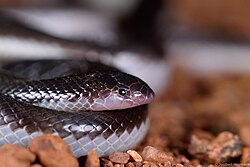Biology:Atractaspis duerdeni
| Atractaspis duerdeni | |
|---|---|

| |
| Scientific classification | |
| Domain: | Eukaryota |
| Kingdom: | Animalia |
| Phylum: | Chordata |
| Class: | Reptilia |
| Order: | Squamata |
| Suborder: | Serpentes |
| Family: | Atractaspididae |
| Genus: | Atractaspis |
| Species: | A. duerdeni
|
| Binomial name | |
| Atractaspis duerdeni Gough, 1907
| |
Atractaspis duerdeni, commonly known as the beaked burrowing asp,[2] Duerden's burrowing asp,[3] and Duerden's stiletto snake,[2] is a species of venomous snake in the family Atractaspididae.[4] The species is native to southern Africa.
Etymology
The specific epithet, duerdeni, is in honor of James Edwin Duerden (1865–1937) of the Albany Museum, Grahamstown, South Africa.[5][6]
Geographic range
A. duerdeni is found in southeastern Botswana, Namibia, and northern South Africa .[2]
Habitat
The preferred natural habitat of A. duerdeni is savanna, at altitudes of 850–1,600 m (2,790–5,250 ft).[1]
Description
In his original description Gough described A. duerdeni as being cream-colored above and below, referring to a faded specimen stored in alcohol.[5] In life A. duerdeni is uniformly blackish-brown or gray dorsally, and it is white or creamish-pink ventrally.[3] The dorsal scales are in 21 rows at midbody. The ventrals number 199; the anal is entire; and the subcaudals number 22, all except the first entire. The snout is prominent and subcuneiform. The rostral has a rounded horizontal edge, and the portion visible from above is a little longer than its distance from the frontal.[5] Females may attain a snout-to-vent length (SVL) of 51 cm (20 in), and males, which are smaller, may attain 44 cm (17 in) SVL.[3]
Behavior
Diet
A. duerdeni preys upon sleeping lizards and snakes.[3]
Reproduction
Venom
A venomous species, A. duerdeni can inflict a serious bite requiring medical attention, but no human fatality has been recorded.[3]
References
- ↑ 1.0 1.1 1.2 Alexander GJ, Tolley KA (2021). "Atractaspis duerdeni ". The IUCN Red List of Threatened Species 2021: https://dx.doi.org/10.2305/IUCN.UK.2021-2.RLTS.T20878118A139702420.en. Accessed on 24 September 2022.
- ↑ 2.0 2.1 2.2 2.3 Species Atractaspis duerdeni at The Reptile Database www.reptile-database.org.
- ↑ 3.0 3.1 3.2 3.3 3.4 Branch, Bill (2004).
- ↑ "Atractaspis ". Integrated Taxonomic Information System. https://www.itis.gov/servlet/SingleRpt/SingleRpt?search_topic=TSN&search_value=209551. Retrieved 29 August 2007.
- ↑ 5.0 5.1 5.2 Gough LH (1907). "Description of a new species of Atractaspis collected at Serowe, North Eastern Kalahari". Records of the Albany Museum 2: 178-179. (Atractaspis duerdeni, new species).
- ↑ Beolens, Bo; Watkins, Michael; Grayson, Michael (2011). The Eponym Dictionary of Reptiles. Baltimore: Johns Hopkins University Press. xiii + 296 pp. ISBN:978-1-4214-0135-5. (Atractaspis duerdeni, p. 76).
Further reading
- Branch, Bill (2004). Field Guide to Snakes and other Reptiles of Southern Africa. Third Revised edition, Second impression. Sanibel Island, Florida: Ralph Curtis Books. 399 pp. ISBN:0-88359-042-5. (Atractaspis duerdeni, p. 63 + Plate 38).
- Broadley, Donald G.; Blaylock, Roger (2013). The Snakes of Zimbabwe and Botswana. Frankfurt am Main, Germany: Edition Chimaira / Serpents Tale. 387 pp. ISBN:978-3899734690.
- Herrmann, Hans-Werner; Branch, Bill (2013). "Fifty years of herpetological research in the Namib Desert and Namibia with an updated and annotated species checklist". Journal of Arid Environments 93: 94–115.
- Schleicher, Alfred (2020). Reptiles of Namibia. Windhoek, Namibia: Kuiseb Publishers. 271 pp. ISBN:978-9994576708.
External links
Wikidata ☰ Q2703555 entry
 |


